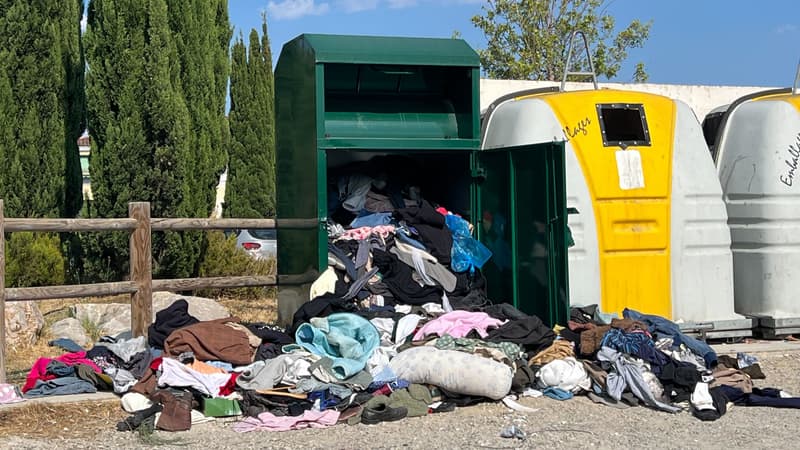Months have spent since it has been going, but the situation has still worsened in recent days. Almost no more recycling container in France can receive used clothes. People are invited to postpone their deposits and store clothes at home.
In this recycling center in southern France, let’s warn from the entrance: “If it is for clothing, it is not even the problem of returning, the company has not come to take them for weeks and we explode there.”
The edges of the container recycling road overflow with clothing forming the tide of textiles.
Due to the accumulated volume, the treatment capacity has reached its limits and the economic equation has no more solution. To the collection costs, you must add “storage costs that exploit” according to the relay. And labor costs that increase.
The relay, a member of the Emmaüs movement, which collects almost two thirds of the annual volumes illustrated the flour of the profession when pouring tons of clothing in front of Kiabi or Decathlon last week. And also suspending collections since July 15. Cooperative society requires a better perception of the textile contribution to equip its accounts. A contribution paid by the consumer during any purchase of new clothes, which amounts to 3 cents per article.
Help that is not really a
Faced with discontent, the State ended up leaving its reservation. The Minister of Ecological Transition, Agnès Pannier-Runacher, announced last Thursday an emergency aid of 49 million euros, which in fact is an open letter to the actors in the sector, which ordered to revalue the financing of the classification.
“We currently play only 0.8 cents per article in the 3 cents taken from any new item. And we are talking about a market of 3.5 billion new items sold per year.”
The government’s mandate would allow the assessment of the ton of ordered clothing from 156 to 223 euros. Now it remains in the Refashion organization, in charge of structuring the sector, to accept the government’s application. What has not yet been done.
Therefore, while Reengash does not accept to pay more for the ton of clothes, Emmanuel Pilloy says that the collection remains suspended.
“The ball is in the ecoorganization camp, adds to the president of the relay. This is a matter of survival. This revaluation will allow us to last a few months and prepare 2026. We had asked for more, but from 156 to 223 euros per ton is better than anything.”
At the moment, Reengalia’s ecoorganism has not responded to the court order, indicating that it is a “considerable effort” and expects the details of the application.
These saturated deposits, sales in second -hand stores that escape … These symptoms, far from being new, converge in the same observation: the textile recycling sector has reached saturation. It becomes impossible to collect and guarantee the use of textiles and shoes in astronomical quantity. The classification and recycling actors, including relay, but also Emaus or the Red Cross report saturated classification centers. The difficulties of the sector are now structural: the imbalance between supply and demand continues to expand.
The offer first. Every year 260,000 tons of clothing are collected, a volume of 15,000 tons compared to 2021. In question, fast-fashion clothing volumes, bought at a very low price in Chinese places such as Shein or Temu, but also brands such as Primark or Boohoo. However, this clothes are sold so economical that your resale in second hand is less advantageous than the sale price. But they are also of poor quality that are not recyclable, the synthetic fibers that are made do not allow it.
And the points of sale, therefore, the sources of income are sleeped. Actually, unlike what we imagine, small clothes collected land in second -hand stores. According to the Ecological Organization of Reengash, 60% of ordered products are reused as it is. But due to their low quality, players are sold quite a lot in the Frip abroad.
“Only 7 to 10% of collected clothes are sold in France. Some clothes, a little more tired, are exported to local actors or our own centers, for example in Senegal or Madagascar, or even in Eastern Europe,” said Emmanuel Pilloy. This also creates direct works abroad. “
But even abroad, the points of sale are more rare, African actors are directed directly to Chinese producers. Reengash stressed on Tuesday in a press release “The sudden drop in export courses for ordered textiles, in Africa, mainly.”
When they cannot be used, some textiles can be recycled in products to other uses, for example, around industry or isolation in the building. Others will serve as fuel, a fun circle for these textiles, many of which are derived from oil.
For observers of the sector, it is difficult to solve the equation, without addressing the roots of the problem. In particular, the economic springs of a sector that only values the classification, not the collection. And especially the problem of excessive consumption. According to Emmaus’s press release, France consumes more than 850,000 tons of textiles every year. Even if France is still a good recycling student, without a more virtuous consumption of extremely polluting products, government help will be only a temporary relief measure.
Source: BFM TV


